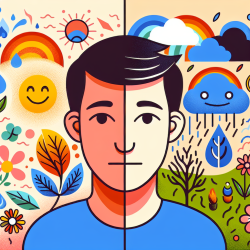The dynamic nature of our emotions is a fascinating subject that has garnered increasing attention in recent years. Affect variability, or the fluctuation in our emotional states, plays a significant role in our mental health. Recent research titled Mean Affect Moderates the Association between Affect Variability and Mental Health sheds light on how these fluctuations impact mental health outcomes.
The Role of Affect Variability
Affect variability refers to the degree of fluctuation in an individual's emotional states over time. This concept is distinct from mean affect levels, which represent the average level of positive or negative emotions experienced by an individual. The study found that greater variability in both positive and negative affects is associated with poorer mental health outcomes such as depression and panic disorder.
Mean Affect as a Moderator
The research highlights the moderating role of mean affect levels on the relationship between affect variability and mental health outcomes. Specifically, it was found that high mean positive affect or low mean negative affect can exacerbate the negative impacts of affect variability on mental health. This suggests that individuals with more desirable mean affect levels (high positive or low negative) may experience worse mental health outcomes when their emotions fluctuate significantly.
Practical Implications for Practitioners
This research offers valuable insights for practitioners working in mental health settings. Here are some ways practitioners can apply these findings:
- Acknowledge Emotional Fluctuations: Recognize that emotional variability is a natural part of human experience and can have significant implications for mental health.
- Focus on Emotional Regulation: Encourage clients to develop skills for regulating their emotions to maintain a stable emotional state, particularly when they have high mean positive affect or low mean negative affect.
- Monitor Emotional Patterns: Use tools and assessments to track clients' emotional patterns over time, identifying those who may be at risk due to high variability.
- Promote Consistent Positive Affect: Help clients engage in activities that promote stable positive emotions while reducing unnecessary fluctuations.
The Path Forward
The findings from this study open up new avenues for future research. Exploring how different interventions can influence affect variability and examining the long-term effects of these interventions on mental health could provide deeper insights into effective therapeutic strategies.
If you're interested in delving deeper into this topic, I encourage you to read the original research paper: Mean Affect Moderates the Association between Affect Variability and Mental Health.










